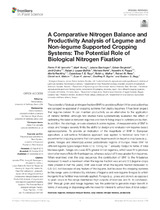A Comparative Nitrogen Balance and Productivity Analysis of Legume and Non-legume Supported Cropping Systems: The Potential Role of Biological Nitrogen Fixation
Autor
Iannetta, Pietro P.M.
Young, Mark
Bachinger, Johann
Bergkvist, Göran
Doltra, Jordi
López-Bellido Garrido, Rafael J.
Monti, Michele
Pappa, Valentini A.
Reckling, Moritz
Topp, Cairistiona F.E.
Walker, Robin L.
Rees, Robert M.
Watson, Christinie A.
James, Euan K.
Squire, Geoffrey R.
Begg, Graham S.
Editor
Frontiers MediaFecha
2016Materia
LegumesCroprotation
Biological nitrogen fixation
Nitrogen balance
METS:
Mostrar el registro METSPREMIS:
Mostrar el registro PREMISMetadatos
Mostrar el registro completo del ítemResumen
The potential of biological nitrogen fixation (BNF) to provide sufficient N for production has encouraged re-appraisal of cropping systems that deploy legumes. It has been argued that legume-derived N can maintain productivity as an alternative to the application of mineral fertilizer, although few studies have systematically evaluated the effect of optimizing the balance between legumes and non N-fixing crops to optimize production. In addition, the shortage, or even absence in some regions, of measurements of BNF in crops and forages severely limits the ability to design and evaluate new legume–based agroecosystems. To provide an indication of the magnitude of BNF in European agriculture, a soil-surface N-balance approach was applied to historical data from 8 experimental cropping systems that compared legume and non-legume crop types (e.g., grains, forages and intercrops) across pedoclimatic regions of Europe. Mean BNF for different legume types ranged from 32 to 115 kg ha−1 annually. Output in terms of total biomass (grain, forage, etc.) was 30% greater in non-legumes, which used N to produce dry matter more efficiently than legumes, whereas output of N was greater from legumes. When examined over the crop sequence, the contribution of BNF to the N-balance increased to reach a maximum when the legume fraction was around 0.5 (legume crops were present in half the years). BNF was lower when the legume fraction increased to 0.6–0.8, not because of any feature of the legume, but because the cropping systems in this range were dominated by mixtures of legume and non-legume forages to which inorganic N as fertilizer was normally applied. Forage (e.g., grass and clover), as opposed to grain crops in this range maintained high outputs of biomass and N. In conclusion, BNF through grain and forage legumes has the potential to generate major benefit in terms of reducing or dispensing with the need for mineral N without loss of total output.

